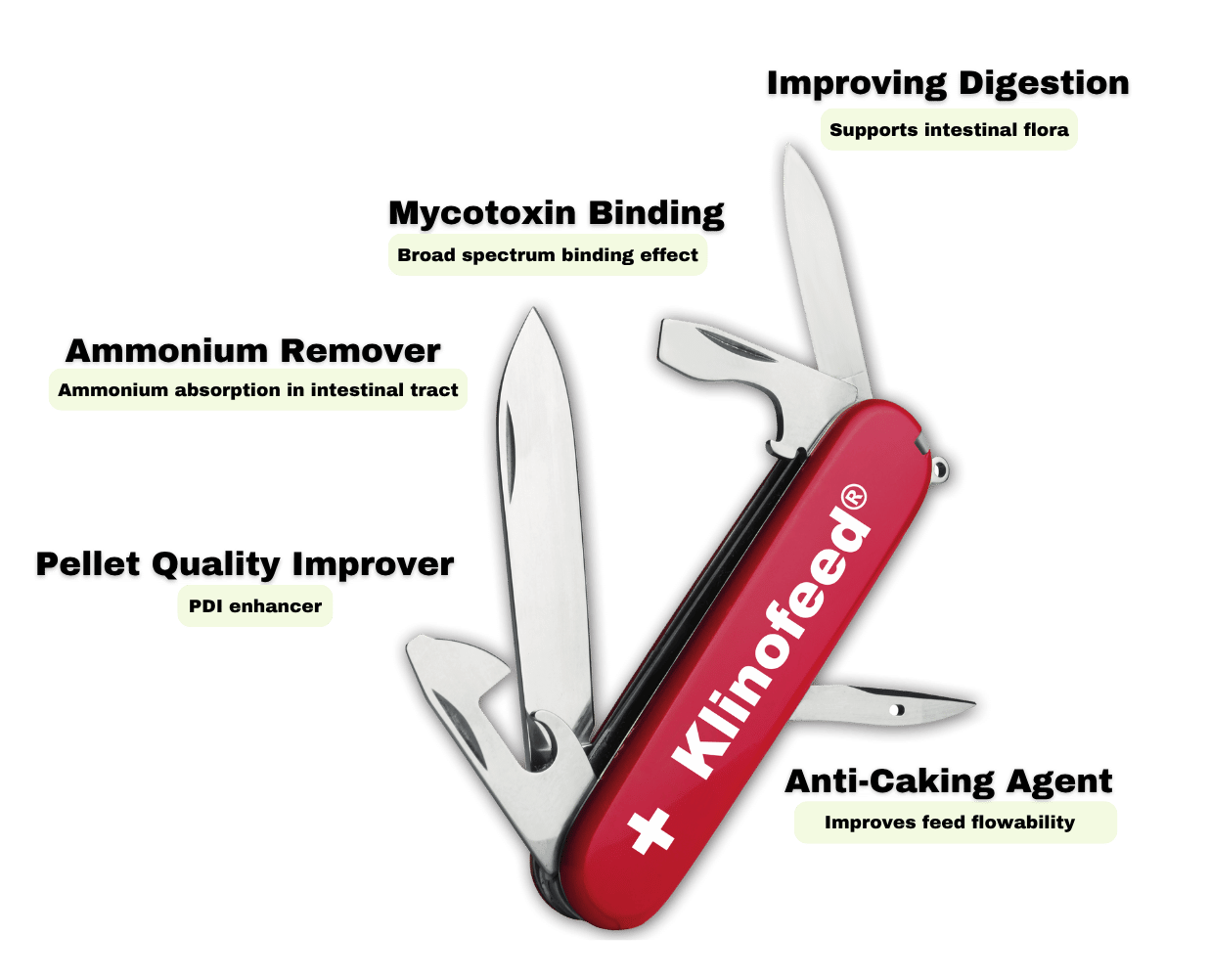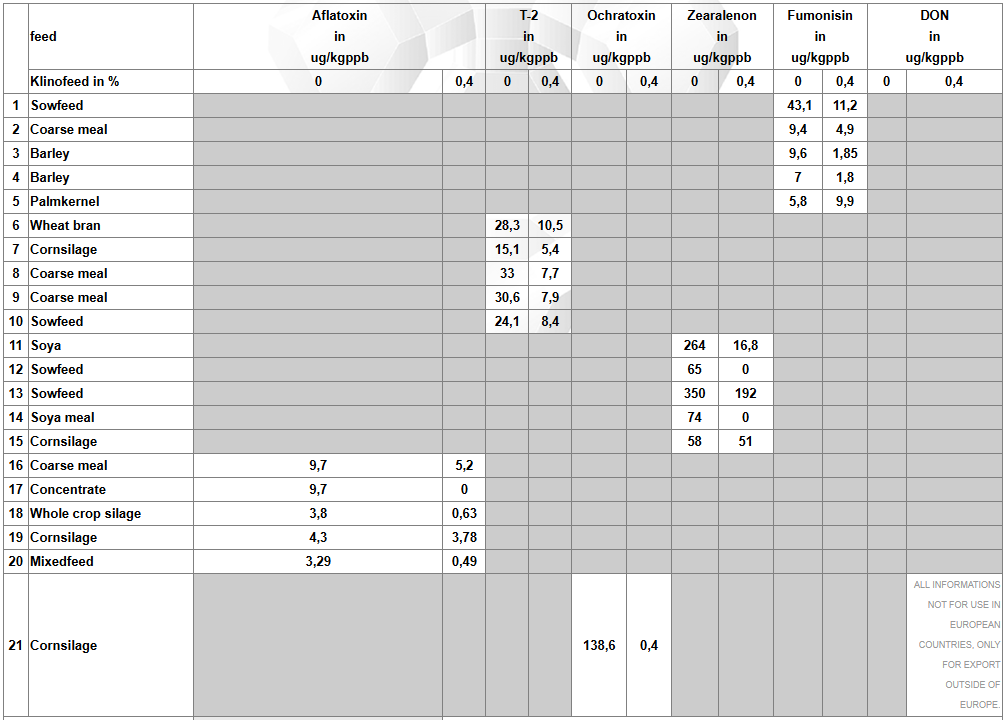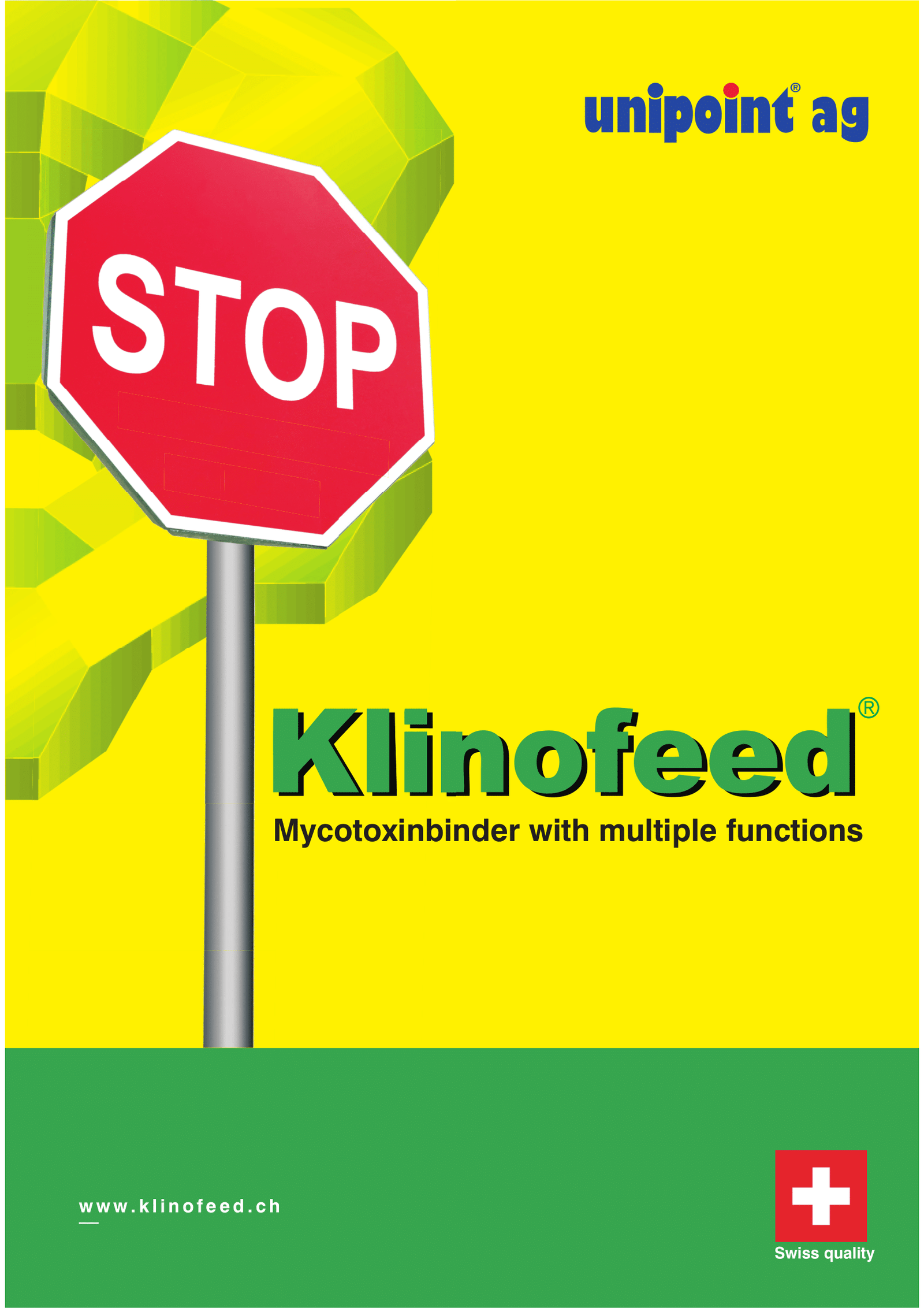Klinofeed
Klinofeed: a benefit for animals and the environment
Klinofeed is prepared from a natural silicon silicate (clinoptilolite of sedimentary origin). This active mineral, with its unique structure and composition, has the ability to bind selectively and irreversibly ammonia and other toxic pollutants within the digestive tract.
Pollutants and ammonia – a problem?
Contaminants such as mycotoxins are poisons produced from the secondary metabolic processes which occur naturally in a variety of molds that grow on food crops.
The amount and type of mycotoxin produced varies depending on the type of mold predominating and on environmental conditions such as temperature and humidity. Levels of mold growth and mycotoxin production in already affected crops may be exacerbated by stresses imposed on the crop by insects, weeds or adverse climatic conditions. Furthermore the harvesting process and storage conditions can promote the production of storage mycotoxins, thus silage, hay and straw are often heavily contaminated.
The effect of mycotoxins on animals varies from acute disease at one extreme to simple metabolic problems that reduce productivity at the other. Mycotoxins can reduce feed consumption and digestion, reduce resistance to disease, increase reproductive problems and generally reduce production and performance.
Ammonia, created in the digestive tract, is highly toxic to livestock even in low concentrations.
In order to limit the damage caused by these contaminants various known measures are employed, one of which is to add silicates to the feed.
Klinofeed is such a silicate. It has a selective and irreversible binding capacity, enabling it to specifically bind ammonia without adsorbing vitamins, trace elements and amino acids. This ability to selectively bind ammonia is unique to Klinofeed.
In the production of animal feed low inclusion rates and cost are very important. Klinofeed meets these and all other legislative requirements for pollutant binders, being approved in the EU Register of Feed Additives (1g568), by EU Organic Farming standards and by the FiBL.
The Function of Klinofeed
Klinofeed is a crystalline silicate and is therefore very porous
Approximately 50% of the silicate consists of pores, each pore having a diameter of exactly 4 Angstroms.
Due to its special production process (conceived by Prof. WM Meier ETHZ) the silicate is active and the pores selectively bind toxins, ammonium and ‘free’ water molecules.
For this reason Klinofeed is frequently used as a selective mycotoxin binder and as a flow improver. Its fine composition gives Klinofeed a very large active surface area of about 500 m² per gram. Klinofeed can also be used as a low-cost pelleting aid.
Safety
Klinofeed is a high quality silicon silicate and free from harmful impurities such as heavy metals, dioxins etc. The manufacturing process is carried out according to a rigorous quality assurance (QA).
The manufacturing process requires a temperature of about 400 degrees Celsius which renders the Klinofeed sterile.
Each production lot is tested and analyzed at the laboratory and each delivery can be traced according to the strict QS.

Use of Klinofeed
Dairy cows:
50 grams per cow per day
Calves: 20-40 kg:
15 grams per calf per day
Newborn calves:
from the 1st day onwards 20 grams Kalbosan (Klinofeed with PSB yeast extract)
Pigs:
Piglets: 5 kg per ton feed
Sows: 5 kg per ton feed
Porkers: 4 – 6 kg per ton feed
Poultry:
1 – 2 kg per ton feed as prevention and low contamination mycotoxin and ammonia binder
3 – 5 kg per ton feed to control mycotoxins and as ammonia binder (also as technical additive and pellet binder)
Fish:
2 – 4 kg per ton feed as to control mycotoxin and ammonia. Further Klinofeed improoves the quality of the pellets.
Klinofeed can be used in all animal feed
• Klinofeed does not bind nutrients such as vitamins, trace elements, amino acids, etc.
• Klinofeed has no affect on raw materials within the feed or in the animal.
• Klinofeed does not bind pharmaceutical products
Major differences of Klinofeed with other products
Klinofeed is approved in the EU feed additive regulation E 568
The crystalline structure of the mineral composition
Klinofeed does not contain, fibers’ (no silicosis)
The high proportion of crystalline silica of about 90%
The binding capacity (23’500mg NH4 + / kg), and the large surface area of 500 m2 = 1 gram
The selective ion exchange series: NH4+ >> K >> Na > Mg > Ca
Klinofeed is also approved as a food additive (E 554), and fulfills the guidelines of the WTO / WHO
Specificationen Klinofeed
| Humidity at 105 Grad C | max. 6% |
| pH | 6,9 -7,1 |
| Specific mass | 2,39 / cm3 |
| Bulk density | 0,7-1,0 g / ccm |
| Specific aera | 460-590m2 / g |
| Ash content | 94,98% at 600°C |
| Symmetry | monoclinie |
| NH4+ substitution capacity | 23’500mg NH4+ / kg |
| Selectivity priority | NH4+ » K » Na > Mg > Ca |
Klinofeed®
| Generic Name: | Double activated HSCAS, Hydrated sodium calcium aluminosilicate, |
| General Formula: | (NaK) 4,CaAl6 (Si30 O72)24H20 |
| Selective Priority: | NH4+ >>K >>Na > Mg > Ca |
| Crystalline Structure: | 4 Angström |
| CAS-Nr. (Chemical Abstract Service Nr) | 12173-10-3 |
Mineral Analysis
| Clino minerals | min. 85 % |
| Clay minerals | ca. 9 % |
| Feldspar | ca. 4 % |
| Mica | ca. 2 % |
| Quartz | 0 % |
Particle Size
| < 5 µm | 10 % |
| 5 to 20 µm | 27 % |
| 20 to 63 µm | 46 % |
| 63 to 125 µm | 16 % |
| > 125 µm | 1 % |
General data Klinofeed
| Specification | mycotoxin binder, anti-caking agent, pellet binder, moisture adsorbent |
| Usage & Dosage | 0,5 – 1,5% |
| Application | mix homogeneously with all types of feed |
| Storage | store in a dry, ventilated area |
| Packing | 25kg paper bags (40 bags per EUR-Pal) 1000kg Big·Bag (1 B.B. / EUR-Pal) bulk im Silo truck |
The solution: Klinofeed
What can you expect from Klinofeed?
For the animals:
Klinofeed binds the ammonium in the indestine tracts and therefore helps the animal in the whole metabolism.
In the stable:
- less odour
- dryer faeces and bedding
- improved environment
- lowered environmental impact
Klinofeed®
1. Binding Mycotoxins
Binding-capacity of Klinofeed at dosage of 4kg/t
Laborory: Biocontrol, Leipzig, Frau Dr. Lindner

2. Studie Klinofeed – Bindung von Mykotoxine
Bindung von Mykotoxinen im Futter Versuche, Klinofeed als ein natürliches Bindemittel für Pilze und deren Mykotoxine, die sich im Futter befinden einzusetzen, haben in mehreren Testreihen Resultate gebracht:
Versuchsreihe im Labor, April 2000
Binding-capacity of Klinofeed at dosage of 4kg/t
Labor: Biocontrol, Leipzig, Frau Dr. Lindner
|
Mycotoxins
|
pilot batch
|
contamination
|
Binding capacity
|
Resultat
|
| DON |
1
|
ppb 414
|
80%
|
82,8 ppb
|
|
2
|
ppb 453
|
72%
|
95,1 ppb
|
|
| Zea |
1
|
ppb 264
|
79%
|
55,4 ppb
|
|
2
|
ppb 65
|
100%
|
0 ppb
|
|
| Aflatoxin |
1
|
ppb 7,1
|
39%
|
4,3 ppb
|
|
2
|
ppb 9,7
|
46%
|
5,2 ppb
|
|
|
3
|
ppb 9,7
|
100%
|
0 ppb
|
|
| Ochratoxin |
1
|
ppb 42
|
66%
|
14,2 ppb
|
Analyse: ELISA Test
3. Blood value chlinical Chemistry
Before– and after using of Klinofeed: (14 days)
Kann durch den Einsatz von Klinofeed die Belastung der Mykotoxine im Blut reduziert werden?
In einem Betrieb in Deutschland mit ca. 2000 Muttersauen wurde das Futter auf Mykotoxine untersucht. Die Resultate waren positiv.
An 20 Sauen des Bestandes wurden Blutproben entnommen und auf die wichtigsten Parameter untersucht. Im Vordergrund standen die Werte der Leber-Enzymausschüttungen.
Nach 14 Tagen Einsatz von 8kg/t Futter Klinofeed wurden den Tieren erneut Blut entnommen und analysiert. Die Leberenzymwerte zeigen den Einfluss von Klinofeed deutlich auf.
| Durchschnittswerte der 20 Proben: |
ASAT (AST) in U/l
Asparat-Amino- Transferase |
y-GT in U/l
Gamma-Gllutamyl Transferase |
AP in U/I
Alkalische Phosphatase |
| blood value before: |
59,7
|
67,44
|
121,9
|
| blood value after: |
27,5
|
29,65
|
113,6
|
| Standard values: |
< 35
|
< 35
|
< 170
|
Labor: Biocontrol, Leipzig, Frau Dr. Lindner
Tierarzt: W. Jost, Ossingen/Zürich
Ossingen, Werner Grossmann
4. Studie – Supplementation on Performance
Ready for healthier animals and sustainable success?
Contact us today for a personalized consultation or discover our products, which are based on over 35 years of research and experience.


